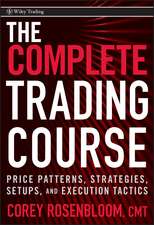Interest Rate Derivatives Explained: Volume 2: Term Structure and Volatility Modelling: Financial Engineering Explained
Autor Jörg Kienitz, Peter Caspersen Limba Engleză Hardback – 24 noi 2017
This book on Interest Rate Derivatives has three parts. The first part is on financial products and extends the range of products considered in Interest Rate Derivatives Explained I. In particular we consider callable products such as Bermudan swaptions or exotic derivatives. The second part is on volatility modelling. The Heston and the SABR model are reviewed and analyzed in detail. Both models are widely applied in practice. Such models are necessary to account for the volatility skew/smile and form the fundament for pricing and risk management of complex interest rate structures such as Constant Maturity Swap options. Term structure models are introduced in the third part. We consider three main classes namely short rate models, instantaneous forward rate models and market models. For each class we review one representative which is heavily used in practice. We have chosen the Hull-White, the Cheyette and the Libor Market model. For all the models we consider the extensions bya stochastic basis and stochastic volatility component. Finally, we round up the exposition by giving an overview of the numerical methods that are relevant for successfully implementing the models considered in the book.
| Toate formatele și edițiile | Preț | Express |
|---|---|---|
| Paperback (1) | 335.55 lei 6-8 săpt. | |
| Palgrave Macmillan UK – 30 aug 2018 | 335.55 lei 6-8 săpt. | |
| Hardback (1) | 321.79 lei 3-5 săpt. | +29.16 lei 6-12 zile |
| Palgrave Macmillan UK – 24 noi 2017 | 321.79 lei 3-5 săpt. | +29.16 lei 6-12 zile |
Preț: 321.79 lei
Nou
Puncte Express: 483
Preț estimativ în valută:
61.57€ • 64.63$ • 51.11£
61.57€ • 64.63$ • 51.11£
Carte disponibilă
Livrare economică 20 martie-03 aprilie
Livrare express 05-11 martie pentru 39.15 lei
Preluare comenzi: 021 569.72.76
Specificații
ISBN-13: 9781137360182
ISBN-10: 1137360186
Pagini: 150
Ilustrații: XXVII, 248 p. 62 illus.
Dimensiuni: 155 x 235 x 23 mm
Greutate: 0.54 kg
Ediția:1st ed. 2017
Editura: Palgrave Macmillan UK
Colecția Palgrave Macmillan
Seria Financial Engineering Explained
Locul publicării:London, United Kingdom
ISBN-10: 1137360186
Pagini: 150
Ilustrații: XXVII, 248 p. 62 illus.
Dimensiuni: 155 x 235 x 23 mm
Greutate: 0.54 kg
Ediția:1st ed. 2017
Editura: Palgrave Macmillan UK
Colecția Palgrave Macmillan
Seria Financial Engineering Explained
Locul publicării:London, United Kingdom
Cuprins
Chapter1 Goals of this Book and Global Overview.- Chapter2 Vanilla Bonds and Asset Swaps.- Chapter3 Callable (and Puttable) Bonds.- Chapter4 Structured Finance.- Chapter5 More Exotic Features.- Chapter6 Basis Hedging.- Chapter7 Exposures.- Chapter8 The Heston Model.- Chapter9 The SABR Model.- Chapter10 Term Structure Models.- Chapter11 Short Rate Models.- Chapter12 A Gaussian Rates-Credit pricing Framework.- Chapter13 Instantaneous Forward Rate Models.- Chapter14 The Libor Market Model.- Chapter15 Numerical Techniques.-
Notă biografică
Jörg Kienitz is Partner at Quaternion Risk Management where he is responsible for business development, pricing models research and risk management consulting. Prior to this he was a Director at Deloitte and Co-lead of the quant team. Before joining Deloitte he was Head of Quantitative Analytics at Deutsche Postbank AG where he was involved in developing/implementing models for pricing, hedging and asset allocation. He lectures at university level on advanced financial modelling and implementation at the universities of Cape Town (UCT) and Wuppertal (BUW) where he is Adjunct Associate Professor, respectively Assistant Professor. Before that he lectured in the part time Masters programme at Oxford University on Financial Mathematics. He is a speaker at a number of major quant finance conferences including Global Derivatives and WBS Fixed Income. Jörg holds a PhD in Probability Theory from Bielefeld University.
Peter Caspers is senior quantitative analyst at Quaternion Risk Management. He has over 17 years of experience as a quant in different banks and is a co-author of QuantLib, an open-source library for quantitative finance. He holds a degree in mathematics and computer science.
Peter Caspers is senior quantitative analyst at Quaternion Risk Management. He has over 17 years of experience as a quant in different banks and is a co-author of QuantLib, an open-source library for quantitative finance. He holds a degree in mathematics and computer science.
Caracteristici
Reviews and analyses the Heston and the SABR model in detail Considers derivatives and volatility modelling Provides an overview of the numerical methods for successfully implementing the models Includes supplementary material: sn.pub/extras





















